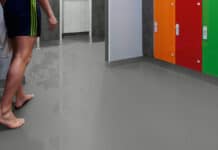
For the second year, Capital One asked full-time professionals their thoughts on workplace design and environment as it relates to their productivity, innovation, and collaboration with colleagues. The results of the 2018 Work Environment Survey found that the 3,500 respondents across the country value flexibility and design, particularly when evaluating whether to stay at their current job or considering a new employment opportunity.
Flexibility is crucial: Professionals increasingly want to work at companies that accommodate a variety of work styles with flexible design, workspaces and hours. In fact, 85% of office professionals surveyed believe flexible workplace design is important and 83% said they have their best ideas when working in flexible space options. Flexible schedules also prove to be crucial to talent attraction and retention— 73% of workers say a flexible schedule is in their top two reasons to stay with a company, and flexible hours was the number one thing workers cited when asked what they expect from their next employer (58%).
Tech expectations: Employee expectations are high across the board, and technology is no exception. A majority of professionals (85%) across the country say it’s important that their next employer be an early adopter of technology, quick to invest in and implement new tech.
Office design drives innovation: For the second year in a row, the majority of office professionals believe companies can’t encourage innovation unless their workplace environment is innovative (79%). Those at the executive level feel even more strongly about this, with 87% agreeing office design is key to encouraging innovation.
“Professionals today have high expectations for their experience in the workplace and what their employer provides for them,” said Stefanie Spurlin, vice president, Workplace Solutions at Capital One. “The results of the 2018 Work Environment Survey clearly demonstrate the importance of design and flexibility to professionals across the country. By providing dynamic spaces to accommodate all kinds of work styles, companies can help facilitate the kind of collaboration and innovation that empowers employees to create breakthrough products and solutions for their customers.”
Design elements in vogue: The most desired design elements for workspaces include: natural light (57%), easily reconfigurable furniture and spaces (37%), artwork and creative imagery (30%), collaborative spaces (30%), and a tie (25%) for bold colors and spaces for rest and relaxation.
Options impact productivity: Offering different kinds of workspaces for employees is crucial, as 80% of respondents say they are more productive when they move to a different room or environment while working.
Location meets its match: When considering a new job, 2 out of 3 (66%) full-time professionals believe that workplace design and environment is equally important or more important than office location. Executive level employees feel even more strongly about this, with more than 3 out of 4 (76%) saying workplace design is as, or more, important than location.
Craving health & wellness benefits: Most office professionals said their company doesn’t currently offer mother’s nursing room (82%); environmentally friendly programs (77%); quiet, reflective spaces (72%); or onsite health center/wellness programs (71%). When asked to prioritize a single onsite benefit, the top responses were healthy food and beverage options (39%); onsite health center/wellness programs (33%); relaxation/social areas (32%); and quiet, reflective space (29%).
Year-over-year data from 2017 and 2018 reflects a sample size of 2,500 full-time professionals from five major markets across the country (500 each from Chicago, Dallas, New York City, San Francisco, and Washington, DC). Aggregated responses showed consistency:
Flexibility: Flexible hours is still the top priority for professionals across these five markets, with 64% in 2017 and 65% in 2018 expecting it from the next company they work for. Responses indicated an increase in the importance of flexible workplace design, with 88% finding it important in 2018, up three percent from 85% in 2017. In 2018, 84% of professionals from the five markets surveyed said that they had their best ideas when they are able to use flexible workspace options, up two points from 2017 at 82%.
Preferred design elements: The top four choices in both years were natural light; easily reconfigurable furniture and spaces; artwork and creative imagery; and collaborative spaces (the same top four at the 2018 national data).
Prioritizing well-being: When asked which benefits professionals would most like to have at their company if it meant forgoing the rest, the top four responses were onsite healthy food and beverage options; relaxation/social areas; onsite health center/wellness programs; and quiet, reflective space (the same top four at the 2018 national data).
The Capital One Work Environment Survey was conducted by Wakefield Research among 3,500 adults, 18 and over, in the U.S., including 1,000 office professionals employed full-time in the U.S., and 500 office professionals employed full time in each of the following DMAs: Chicago, Dallas, New York City, San Francisco and Washington, D.C., between April 19 and May 2, 2018 using an email invitation and an online survey. Data from 2018 reflects the full 3,500 sample size, and year-over-year data is limited to the 2,500 respondents (total of the 500 from each market) that was the same sample set for the 2017 survey, for accuracy and data integrity.
Results of any sample are subject to sampling variation. The magnitude of the variation is measurable and is affected by the number of interviews and the level of the percentages expressing the results. For the interviews conducted in this particular study, the chances are 95 in 100 that a survey result does not vary, plus or minus, by more than 3.1 percentage points for the national sample and 4.4 percentage points for each of the DMAs from the result that would be obtained if interviews had been conducted with all persons in the universe represented by the sample.




















![[VIDEO] Collect Asset Data at the Speed of Walking a Building](https://facilityexecutive.com/wp-content/uploads/2024/02/maxresdefault-324x160.jpg)